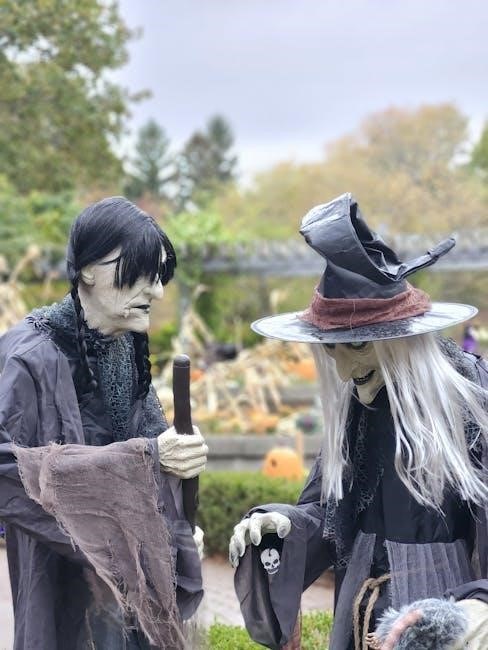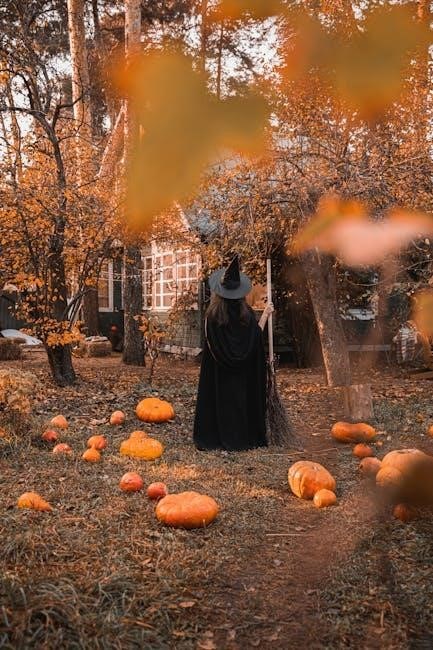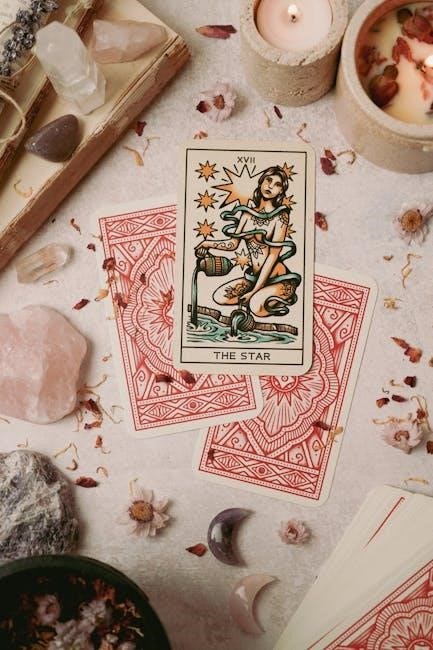Welcome to the world of witchcraft, a spiritual practice embracing magic, nature, and personal growth. This beginner’s guide explores the basics, helping you start your journey confidently.
1.1 What is Witchcraft?
Witchcraft is a spiritual practice that combines magic, nature, and personal growth. It involves working with energy, intention, and the natural world to manifest change. Rooted in ancient traditions, witchcraft is diverse, with various forms like Wicca and traditional practices. It emphasizes harmony with the environment and the use of tools such as crystals, herbs, and rituals. Witchcraft is not limited to any specific religion or background, making it accessible to everyone. It’s a journey of self-discovery, empowerment, and connecting with the universe’s energy. Whether for healing, protection, or personal transformation, witchcraft offers a powerful way to align with your goals and the world around you.

1.2 A Brief History of Witchcraft
Witchcraft has ancient roots, with practices dating back thousands of years across various cultures. Early forms often centered on nature, spirituality, and survival, with rituals tied to seasonal cycles and natural phenomena. During the Middle Ages, witchcraft became associated with fear and persecution, leading to widespread witch hunts. The Renaissance revived interest in occult practices, blending folklore with modern spirituality. In the 20th century, Wicca emerged, popularizing witchcraft as a structured, nature-based religion. Today, witchcraft is a diverse, global practice, embracing both traditional and modern approaches. Its evolution reflects humanity’s enduring connection to magic, nature, and the mysteries of the universe.

Types of Witchcraft
Witchcraft encompasses various traditions, including Hedge Witchcraft, focusing on nature and herbalism, and Crystal Witchcraft, utilizing stones for magical practices. Each path offers unique spiritual expression.
2.1 Wicca and Modern Witchcraft
Wicca, a modern witchcraft tradition, emphasizes harmony with nature and the divine. Founded in the mid-20th century, it blends ancient rituals with contemporary practices, focusing on the balance of masculine and feminine energies. Wiccans celebrate seasonal Sabbats and honor the God and Goddess through structured rituals. Modern witchcraft often incorporates Wiccan principles, offering a flexible framework for personal spirituality. It encourages individuals to explore magic, spell-casting, and the use of tools like crystals and herbs. This approach makes Wicca accessible to beginners, providing a structured yet adaptable path for those seeking to connect with nature and their inner selves.
2.2 Traditional Witchcraft
Traditional witchcraft, often rooted in folklore and regional customs, differs from modern practices like Wicca. It emphasizes ancestral wisdom, local spirits, and practical magic for everyday life. This path focuses on the cycles of nature and the elements, with rituals often tied to specific landscapes or family traditions. Traditional witches may use herbs, stones, and simple tools passed down through generations. Unlike Wicca, it doesn’t follow a structured system but instead adapts to personal and cultural contexts. For beginners, exploring traditional witchcraft offers a deep connection to history and the natural world, encouraging a personalized and intuitive approach to magic and spirituality.
Setting Up Your Witchcraft Practice
Creating a sacred space and gathering essential tools are key to starting your witchcraft journey. Focus on intention, energy, and personal connection to craft meaningful rituals and practices.
3.1 Creating a Sacred Space
Creating a sacred space is essential for your witchcraft practice, as it provides a focused environment for rituals and spells. Start by decluttering and cleansing the area with sage or incense. Add symbols, such as pentacles or elemental representations, to enhance the energy. Incorporate natural elements like plants, crystals, or a bowl of water to connect with nature. Consider using a altar cloth and candles to create a calming ambiance. This space should reflect your personal energy and intentions, making it a sanctuary for spiritual growth and magic. Personalize it with items that resonate with you, ensuring it feels sacred and meaningful.
3.2 Essential Tools for Beginners
Starting your witchcraft journey requires a few essential tools to enhance your practice. A wand or athame is used to direct energy, while crystals and stones amplify intentions. Candles in various colors represent different energies and purposes. Tarot cards or runes can aid in divination, offering guidance and insight. A journal is crucial for documenting spells, rituals, and progress. Incense or sage is used for cleansing and purifying your sacred space. A chalice or cauldron symbolizes water and transformation, while a pentacle represents earth and protection. These tools help create a structured and meaningful practice, allowing you to focus your energy and intentions effectively.
Understanding Magic
Magic is the art of shaping reality through intention and energy. It’s a natural force harnessed with focus, belief, and practice, making the impossible possible.

4.1 The Basics of Spell Casting
Spell casting is a fundamental practice in witchcraft, involving the manipulation of energy to achieve a specific goal. It begins with setting a clear intention, visualizing the desired outcome, and channeling focused energy. Tools like candles, herbs, or crystals can enhance the ritual, but the core power lies within the practitioner’s will and belief. A calm and centered mindset is essential, as emotions and thoughts influence the spell’s effectiveness. Beginners should start with simple spells, such as candle magic or herbal rituals, to build confidence and skill. Consistency and patience are key, as magic often unfolds gradually. Remember, the energy you put forth shapes the result.
4.2 The Role of Intention and Energy
Intention and energy are the heart of spell casting, driving the manifestation of desires. Intention is the clear, focused goal you set, while energy is the force that fuels it; Emotions, thoughts, and actions align to channel this energy, making it vital to maintain a positive and focused mindset. Beginners should practice grounding techniques, such as meditation, to stabilize their energy. The strength of your intention determines the spell’s effectiveness, so clarity and belief are crucial. Remember, energy flows where attention goes, so keep your focus unwavering. Harnessing intention and energy wisely ensures ethical and powerful magic.

Spells and Rituals
Spells and rituals are foundational to witchcraft, offering ways to manifest change. Simple spells for protection, abundance, and healing are perfect for beginners. Seasonal celebrations like Halloween enhance magical practices, while tools like candles and herbs amplify intentions. Start with clear goals and positive energy to ensure effective results. Explore various rituals to connect with nature and honor cycles of life, making magic a meaningful part of your daily journey. Always approach with respect and intention, keeping practices ethical and personal. This foundational practice will deepen your understanding and connection to the craft, fostering growth and transformation. Keep it meaningful and aligned with your values for the best outcomes.
5.1 Simple Spells for Beginners
Simple spells are a great way to start your witchcraft journey. Begin with protection spells using candles or herbs, which create a safe, positive environment. Healing spells, like charging water with intention, can aid physical or emotional well-being. Abundance spells, such as carrying a citrine crystal, attract prosperity. Start with clear intentions and basic tools like candles, herbs, or crystals. Keep rituals short and focused, ensuring ethical practices. These spells build confidence and connect you to magic’s power. Always visualize your desired outcome and infuse your actions with positive energy. Safety and respect are key, so avoid complex spells until you gain experience. This foundational approach will help you grow into a skilled practitioner.
5.2 Seasonal and Lunar Rituals
Seasonal and lunar rituals are powerful ways to connect with nature and the universe. Celebrate Sabbats like Samhain or Yule to honor the changing seasons. Lunar rituals, such as New Moon for setting intentions and Full Moon for releasing energy, align your magic with natural cycles. Use candles, herbs, and crystals to enhance these practices. For example, light blue, red, and white candles during a coronation ritual or burn sage for purification. These rituals help you attune to the earth’s rhythms and amplify your spells. Start simple, focusing on meaningful actions and intentions. Over time, these practices will deepen your connection to the divine and enhance your magical work.
Divination and Witchcraft
Divination in witchcraft involves tools like tarot cards and crystals to gain insights and guide decisions. These practices help witches connect with their intuition and the universe, enhancing spellcasting and personal growth.
Tarot cards are a powerful tool for self-discovery, decision-making, and connecting with the universe. A standard deck contains 78 cards, divided into the Major and Minor Arcana. The Major Arcana represents life’s major themes and transitions, while the Minor Arcana reflects everyday situations and emotions. For beginners, starting with simple three-card spreads (past, present, future) or single-card draws can provide clarity. Tarot is not about predicting the future but understanding the present and guiding actions. Regular practice enhances intuition and deepens your connection to magic. Trust your interpretations, and remember, tarot is a personal journey unique to each practitioner.
6.2 Using Crystals and Stones
Crystals and stones are potent tools in witchcraft, believed to hold unique energies and vibrations. They can amplify spells, protect spaces, and promote healing. Popular stones like clear quartz, amethyst, and black tourmaline are often used for their specific properties. To harness their power, cleanse and charge them under moonlight or with sage. Programming a crystal involves setting an intention, making it a focused tool for your magic. Carry them for personal protection or place them in sacred spaces to enhance energy. Crystals also aid in meditation and divination, connecting you deeper to nature and your practice. Their versatility makes them invaluable for beginners exploring witchcraft.
Herbal Magic
Herbal magic harnesses the power of plants for spells, healing, and protection. Common herbs like sage, chamomile, and lavender are used in rituals and potions to enhance well-being and manifest intentions.
7.1 Herbs for Protection and Healing
Herbs are a cornerstone of magical practices, offering natural ways to promote healing and protection. Sage is widely used for cleansing and warding off negative energy, while chamomile calms the mind and body. Lavender, known for its soothing properties, enhances peace and protects against harm. These herbs can be incorporated into spells, rituals, or even as simple remedies to foster well-being. By understanding their properties, beginners can harness their power to create protective barriers and promote healing in both physical and spiritual realms.
7.2 Creating Herbal Spells
Creating herbal spells is a simple yet powerful way to harness nature’s magic. Start by selecting herbs that align with your intention, such as sage for cleansing or chamomile for calm. Define your goal clearly, then prepare the herbs by drying or grinding them. Charge the herbs with your energy by focusing on your intent while handling them. Use the herbs in spells by burning them, adding them to sachets, or infusing them in water. For example, a sleep spell might involve placing chamomile under your pillow, while a protection spell could use sage in a smudging ritual. Experiment with combinations to enhance their effects and personalize your magic.

Crystal Magic
Crystal magic harnesses the vibrational energy of crystals to amplify spells and rituals. It connects practitioners to nature’s power, enhancing intentions and manifesting desired outcomes effectively.
8.1 The Power of Crystals in Witchcraft
Crystals are powerful tools in witchcraft, believed to hold unique energies that amplify spells and rituals. Each crystal, like quartz or amethyst, has specific properties for healing, protection, or manifestation. By tuning into their vibrations, practitioners can channel these energies to enhance their magical work. Whether used in grids, worn as jewelry, or carried as talismans, crystals serve as bridges between the physical and spiritual realms. Their ability to absorb, store, and release energy makes them indispensable for beginners seeking to deepen their practice and connect with nature’s magic. This natural resonance aligns perfectly with witchcraft’s core principles of harmony and intention.
8.2 Charging and Cleansing Crystals
Charging and cleansing crystals are essential steps to prepare them for magical use. Cleansing removes negative energies, while charging infuses them with intention. Methods include moonlight exposure, smudging with sage, or burying in earth. Placing crystals under a full moon harnesses lunar energy, while smudging purifies their vibrations. Some witches use sea salt baths or sound healing for cleansing. Once cleansed, charging involves setting a specific intention, such as protection or healing. Regular maintenance ensures crystals remain effective tools in spells and rituals. Proper care enhances their power, making them reliable allies in a witch’s practice. This process connects deeply with nature and magic.

The Wheel of the Year
The Wheel of the Year is a cycle of eight Sabbats celebrating nature’s seasons. It includes Yule, Ostara, Samhain, and Beltane, honoring life, death, and renewal.
9.1 Celebrating Sabbats
Celebrating Sabbats is a cornerstone of witchcraft, marking the Wheel of the Year. These eight festivals honor nature’s cycles, from Yule’s rebirth to Samhain’s ancestors. Each Sabbat has unique rituals, such as lighting Yule logs or Ostara’s egg decorating. Beginners can create altars with seasonal symbols like evergreen for Yule or flowers for Beltane. Rituals often include feasting, spellwork, and connecting with nature. Whether solitary or in groups, Sabbats foster spiritual growth and harmony with the earth. They remind us of life’s rhythms, offering moments to reflect and celebrate. Start by choosing a Sabbat that resonates with you, like Halloween’s Samhain, and gradually explore others.

9.2 Seasonal Rituals and Practices
Seasonal rituals and practices are integral to witchcraft, helping practitioners connect with nature’s cycles. These rituals often coincide with Sabbats and lunar phases, fostering harmony with the earth. Beginners can start with simple activities like spring cleaning for renewal, summer solstice bonfires, or autumn harvest celebrations. Decorating altars with seasonal symbols, such as pumpkins for Samhain or evergreen for Yule, enhances the experience. Rituals may include meditation, spellwork, or gratitude ceremonies. These practices deepen one’s connection to the natural world and amplify magical intentions. By embracing seasonal rituals, witches honor the ever-turning Wheel of the Year, finding balance and meaning in life’s rhythms.

Witchcraft Community and Resources
Explore online forums, social media groups, and local covens to connect with fellow witches. Etsy offers magical tools, while books like Rashme Oberoi’s guide provide valuable insights for beginners.
10.1 Finding a Witchcraft Community
Connecting with a witchcraft community can enrich your journey, offering support and shared knowledge. Online forums, social media groups, and local covens provide spaces to meet fellow practitioners. Attend workshops, rituals, or seasonal events like Sabbats to build connections. Many witches gather for spell-casting ceremonies, such as those in support of significant events. Etsy and online marketplaces also host communities selling magical tools and resources. Books like Rashme Oberoi’s guide offer insights and inspiration. Embrace these opportunities to learn, grow, and find like-minded individuals who share your passion for witchcraft.
- Join online forums and social media groups.
- Attend local workshops and seasonal rituals.
- Explore Etsy for magical tools and resources.
- Read recommended books for guidance and inspiration.
10.2 Recommended Books and Online Resources
Exploring recommended books and online resources can deepen your understanding of witchcraft. Books like Wicca: A Magical Journey with Spells and Rituals by Rashme Oberoi offer practical guidance for beginners. Online platforms like Etsy provide access to magical tools, spells, and herbal supplies. Social media groups and forums are excellent for connecting with practitioners and finding inspiration. Websites dedicated to witchcraft often feature tutorials, spell ideas, and articles on various traditions. These resources help you navigate your journey, whether you’re interested in Wicca, crystal magic, or herbalism. They also offer a wealth of knowledge to enhance your practice and keep you inspired.
- Books: Wicca: A Magical Journey with Spells and Rituals, The Spiral Dance by Starhawk.
- Online: Etsy, witchcraft forums, and social media groups.

Safety and Etiquette
Practicing witchcraft safely involves ethical considerations and avoiding common mistakes. Always set clear intentions and respect the craft’s principles to ensure a positive and responsible magical journey.
- Respect nature and others’ beliefs.
- Use magic responsibly and with integrity.
11.1 Ethical Considerations in Witchcraft
Witchcraft is deeply rooted in ethical practices, emphasizing harmony with nature and respect for others. The Threefold Law and the Wiccan Rede guide many, teaching that actions return threefold and to harm none. Beginners should focus on responsible magic, avoiding manipulation or harm. Ethical witchcraft encourages self-reflection, ensuring intentions align with positive outcomes. Respect for others’ beliefs and boundaries is crucial. Avoid using magic for selfish or malicious purposes. Instead, embrace a mindset of healing, protection, and growth. By adhering to these principles, you foster a practice grounded in integrity and compassion, creating a safe and meaningful journey in witchcraft.
11.2 Common Mistakes to Avoid
When starting your witchcraft journey, it’s important to avoid common pitfalls. Rushing spell casting without proper preparation or intention can lead to ineffective results. Neglecting to cleanse and charge tools before use is another mistake, as it diminishes their magical potential. Overcomplicating rituals can create confusion and reduce focus. Beginners often overlook the importance of grounding and centering, which are essential for maintaining balance during practices. Additionally, ignoring ethical guidelines, such as the Threefold Law, can lead to unintended consequences. Avoid using magic for manipulation or harm, as this violates core principles. By being mindful of these mistakes, you can cultivate a more meaningful and effective practice.
Tracking Your Progress
Keeping a magical journal helps monitor your growth and reflect on practices. Regularly reviewing your journey ensures clarity and improvement in your witchcraft path over time.
12.1 Keeping a Magical Journal
A magical journal is a powerful tool for reflection and growth in your witchcraft journey. It allows you to document spells, rituals, and personal insights, helping you track progress over time. By recording your experiences, you can identify patterns, refine techniques, and celebrate successes. Include details like intentions, materials used, and outcomes to gain deeper understanding. This practice fosters accountability and enhances your connection to your craft. Over time, your journal becomes a cherished record of your magical evolution, offering guidance and inspiration as you continue to explore the world of witchcraft.
12.2 Reflecting on Your Practice
Reflecting on your witchcraft practice is essential for growth and understanding. Regularly reviewing your experiences helps identify strengths, areas for improvement, and the effectiveness of your spells and rituals. Consider questions like, “What worked well?” and “What could I do differently?” This introspection deepens your connection to your craft and clarifies your intentions. Over time, reflection fosters a more mindful and intentional practice, allowing you to evolve as a witch. By embracing this process, you cultivate self-awareness and enhance your magical journey, ensuring each step aligns with your personal and spiritual goals.
